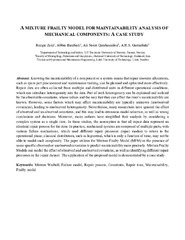| dc.contributor.author | Zaki, Rezgar | |
| dc.contributor.author | Barabadi, Abbas | |
| dc.contributor.author | Garmabaki, Amir Hossein Soleiman | |
| dc.contributor.author | Nuri, Ali | |
| dc.date.accessioned | 2020-03-27T12:16:46Z | |
| dc.date.available | 2020-03-27T12:16:46Z | |
| dc.date.issued | 2019-11-07 | |
| dc.description.abstract | Knowing the maintainability of a component or a system means that repair resource allocations, such as spare part procurement and maintenance training, can be planned and optimized more effectively. Repair data are often collected from multiple and distributed units in different operational conditions, which can introduce heterogeneity into the data. Part of such heterogeneity can be explained and isolated by the observable covariates, whose values and the way that they can affect the item’s maintainability are known. However, some factors which may affect maintainability are typically unknown (unobserved covariates), leading to unobserved heterogeneity. Nevertheless, many researchers have ignored the effect of observed and un-observed covariates, and this may lead to erroneous model selection, as well as wrong conclusions and decisions. Moreover, many authors have simplified their analysis by considering a complex system as a single item. In these studies, the assumption is that all repair data represent an identical repair process for the item. In practice, mechanical systems are composed of multiple parts, with various failure mechanisms, which need different repair processes (repair modes) to return to the operational phase; classical distribution, such as lognormal, which is only a function of time, may not be able to model such complexity. The paper utilizes the mixture frailty model (MFM) in the presence of some specific observed or unobserved covariates to predict maintainability more precisely. MFMs can model the effect of observed and unobserved covariates, as well as identifying different repair processes in the repair dataset. The application of the proposed model is demonstrated by a case study. | en_US |
| dc.description | This is a post-peer-review, pre-copyedit version of an article published in <i>International Journal of System Assurance Engineering and Management.</i> The final authenticated version is available online at: http://dx.doi.org/10.1007/s13198-019-00917-3. | en_US |
| dc.identifier.citation | Zaki, R.; Barabadi, A.; Qarahasanlou, A.N.; Garmabaki, A.H.S. (2019) A mixture frailty model for maintainability analysis of mechanical components: a case study.<i> International Journal of Systems Assurance Engineering and Management, 10,</i> (6),1646-1653 | en_US |
| dc.identifier.cristinID | FRIDAID 1752061 | |
| dc.identifier.doi | 10.1007/s13198-019-00917-3 | |
| dc.identifier.issn | 0975-6809 | |
| dc.identifier.issn | 0976-4348 | |
| dc.identifier.uri | https://hdl.handle.net/10037/17895 | |
| dc.language.iso | eng | en_US |
| dc.publisher | Springer Nature | en_US |
| dc.relation.ispartof | Zaki, R. (2020). Performance Measurement System in complex environment: observed and unobserved risk factors. (Doctoral thesis). <a href=https://hdl.handle.net/10037/19902>https://hdl.handle.net/10037/19902</a> | |
| dc.relation.journal | International Journal of Systems Assurance Engineering and Management | |
| dc.rights.accessRights | openAccess | en_US |
| dc.rights.holder | Copyright 2019 Springer | en_US |
| dc.subject | VDP::Technology: 500::Mechanical engineering: 570::Production and maintenance engineering: 572 | en_US |
| dc.subject | VDP::Teknologi: 500::Maskinfag: 570::Produksjon og driftsteknologi: 572 | en_US |
| dc.title | A mixture frailty model for maintainability analysis of mechanical components: a case study | en_US |
| dc.type.version | acceptedVersion | en_US |
| dc.type | Journal article | en_US |
| dc.type | Tidsskriftartikkel | en_US |
| dc.type | Peer reviewed | en_US |


 English
English norsk
norsk